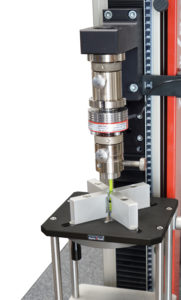Citation: Moersch W, “Product Showcase: ZwickRoell Parenteral Device Testing Platform”. ONdrugDelivery Magazine, Issue 105 (Feb 2020), p 66.
In 2020 several billion prefilled syringes (PFSs) were sold worldwide and the market continues to grow. Anticoagulants and vaccines dominated the PFS market, but the number of biologics stored and administered in PFSs is steadily increasing. These PFSs are also used in autoinjectors. Due to the sensitivity during storage and the complexity of their action mechanism for administration, they must meet high requirements, for which ZwickRoell offers a wide variety of standardised test fixtures.
TESTING PFS TO ISO 11040 -4, -6 & -8
ISO 11040 for PFSs (Part 4: Glass barrels for injectables and sterilised sub-assembled syringes ready for filling, Part 6: Plastic barrels for injectables and sterilised sub-assembled syringes ready for filling, and Part 8: Requirements and test methods for finished PFSs) describes 10 mechanical tests. ZwickRoell has a complete portfolio of products to satisfy the requirements of ISO 11040 -4, -6 and -8. The variable test fixtures are suitable for a wide range of syringe types and geometries. Some tests require a testing machine with additional torsion drive. The universal test fixture for syringes can also be used for tests on carpules by means of suitable adapters. Torsion and leakage tests are described in ISO 80369. An overview of the tests:

Figure 1: Glide force test.
- C1: Flange breaking resistance
- C2: Luer cone breaking resistance
- E: Glide force test for evaluation of syringe lubrication (Figure 1)
- F: Needle penetration force test
- G1: Needle pull-out force
- G2: Closure system liquid leakage test
- G3: Luer lock adapter collar pull-off force
- G4: Luer lock adapter collar torque resistance
- G5: Luer lock rigid tip cap unscrewing torque
- G6: Pull-off force of tip cap or needle shield
TESTING OF THE LUER/LUER LOCK CONNECTIONS
The Luer cone is a standardised connector system used in tube systems in the medical industry. It is used with items such as cannulae, syringes, catheters, three-way stopcocks, and infusion tubes. The seal is achieved through use of a cone-shaped fitting, called a Luer cone. Furthermore, the Luer lock connector has a threaded sleeve to achieve a tight connection so fluids cannot escape.
For quality control of these components, a materials testing machine with superimposed torsion drive is used. The ISO 80369 Part 7 and Part 20 standards are used to test a Luer system or Luer lock connection for stability through various tests. The superimposed axial/torsion drive of a zwickiLine torsion materials testing machine enables easy determination of torques under static axial load. The test fixtures also allow for leak tests.
SERIAL, PARALLEL AND FULLY AUTOMATIC SYRINGE TESTING
If it is necessary to test a large number of syringes in a short time a materials testing machine with a carousel or an X-Y table can be used. A large number of specimens can be fed to the machine via a magazine and automatically tested one after the other. Operator influence on the test is reduced, resulting in greater stability in MSA/Gauge R&R studies.
Reliable test results are a basic requirement when testing medical and pharmaceutical products. Extensive automation improves test-result reproducibility, minimises operator influence and simplifies validation using measurement system analysis studies. In addition to the automated test sequence, various handling systems provide automatic specimen feed. Another application concerns, for example, syringes used in syringe drivers. In this case the syringe plungers are depressed over a lengthy period.
TRACEABLE, TAMPER-PROOF TEST RESULTS
Ever-increasing demands are placed on software used in the medical and pharmaceutical industries to document the traceability of completed actions, and guarantee data integrity. The testXpert III testing software’s traceability option enables logging of actions and changes before, during and after the test, making test results and documentation traceable and safeguarding them against tampering. Integrated user management and functions including electronic records and an electronic signature ensure that test results are protected against manipulation at all times. Together with the organisational measures and procedure instructions that apply to the individual companies themselves, the requirements of US FDA in 21 CFR Part 11 are fulfilled.

